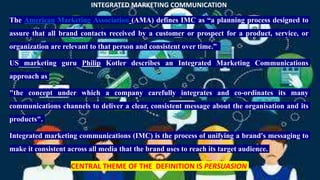The document discusses integrated marketing communication (IMC). IMC is defined as a planning process that ensures all brand contacts with customers are relevant, consistent, and deliver a clear message. IMC involves unifying a brand's messaging across all media to reach its target audience. There are four main reasons IMC is important: 1) ensuring consistency throughout the customer journey, 2) helping with brand building, 3) boosting campaign effectiveness through the right marketing channel mix, and 4) reinforcing marketing channels. The document then discusses various IMC concepts like the promotion process model, common promotion methods, and the five-step IMC communication process model.














































